一 : 循环队列操作
不是只有排序,二叉树才叫数据结构,面试栽在基本的数组和队列,链表,栈的有的是!!!本文对循环队列的重要操作作出总结。[www.61k.com]注:为了避免队列空和满两个状态混淆,
采用空闲一个位置的方式,即N个元素空间的循环队列最多只能存放N-1个有效元素。这也是大多数教材的做法。
1) 循环队列初始化:front=rear=0;
2)入队操作:rear=(rear+1)%size;
3)出队操作:front=(front+1)%size;
4)判断是否为空队列:front==rear;
5)判断队列是否已满:front=(rear+1)%size;
6)遍历队列各元素。
#include <stdio.h> #include <stdlib.h> #include <malloc.h> #include <stdbool.h> //注意使用布尔类型时,需要引入此头文件 /******************************************************************************************************************* 定义循环队列的结构体。注:循环队列是在数组的基础上实现的,所以需要一个指向首元素的指针,另外头和尾用int来表示相对偏移量即可。 ********************************************************************************************************************/ typedef struct Queue { int * qBase; int front; int rear; }QUEUE; void initQueue(QUEUE *pq); void enQueue(QUEUE *pq , int value); bool isemptyQueue(QUEUE *pq); bool is_fullQueue(QUEUE *pq); void deQueue(QUEUE *pq , int *value); void traverseQueue( QUEUE *pq); /***************************************** 主函数测试入口 ********************************************/ int main(){ int val; QUEUE queue = {NULL,0,0} ; initQueue(&queue); enQueue(&queue,4); enQueue(&queue,5); enQueue(&queue,6); enQueue(&queue,7); enQueue(&queue,72); enQueue(&queue,42); traverseQueue(&queue); deQueue(&queue , &val); deQueue(&queue , &val); traverseQueue(&queue); enQueue(&queue,55); enQueue(&queue,65); traverseQueue(&queue); return 0; } /**************************************初始化一个空的循环队列 ******************************************/ void initQueue(QUEUE *pq){ pq->qBase = (int *)malloc(sizeof(int)*6); if(pq->qBase == NULL){ printf("内存分配失败!n"); exit(-1); } pq->front = pq->rear = 0; } /***************插入一个新元素 注:插入前需要先判断该队列是否已满,避免覆盖有效数据******************/ void enQueue(QUEUE *pq , int value){ if(is_fullQueue(pq)){ printf("循环队列已满,拒绝插入%d!n",value); } else{ pq->qBase[pq->rear] = value; pq->rear = (pq->rear + 1)%6 ; printf("n %d 入队 n" , value); } } /************** 删除一个元素,并通过指针返回该数 注:删除前要判断该队列是否为空。*******************/ void deQueue(QUEUE *pq , int *value){ if(isemptyQueue(pq)){ printf("循环队列已空!"); } else{ *value = pq->qBase[pq->front]; printf("n %d 出队 n",*value); pq->front = (pq->front + 1)%6 ; } } /************************************ 判断循环队列是否为空 ************************************/ bool isemptyQueue(QUEUE *pq){ if(pq->front == pq->rear){ return true; } else return false; } /************************************ 判断循环队列是否已满 ************************************/ bool is_fullQueue(QUEUE *pq){ if((pq->rear +1)%6 == pq->front){ return true; }else return false; } /************************************* 遍历循环队列中的各元素 *************************************/ void traverseQueue( QUEUE *pq){ if(isemptyQueue(pq)){ printf("循环队列为空!n"); exit(0); } printf("当前循环队列 :n"); printf("front是%d,rear是%d :n",pq->front,pq->rear); int tail = pq->front ; while(tail != pq->rear){ printf(" %d ",pq->qBase[tail]); tail = (tail + 1)%6; } }二 : 队列之顺序队列与循环队列
一、队列的概念 只能在表的一端进行插入操作,只能在表的另一端进行删除操作,这种数据结构称为队列。把允许插入的一端叫队尾(rear),允许删除的一端叫对头(front)。二、队列的分类 队列本身也是一种线性表,因而和线性表一样也有顺序和链式存储结构两种存储方式。 采用顺序存储结构实现的队列称为顺序队列; 采用链式存储结构实现的队列称为链队列。
三、顺序队列1、顺序队列的表示①顺序队列用一个向量空间(一般使用一维数组)来存放当前队列中的元素。
②由于队列的队头和队尾的位置是变化的,设置两个指针front和rear分别指示队头元素和队尾元素在向量空间中的位置,它们的初值在队列初始化时均应置为0。
2、 顺序队列的基本操作
①入队时:将新元素插入rear所指的位置,然后将rear加1。
②出队时:删去front所指的元素,然后将front加1并返回被删元素。
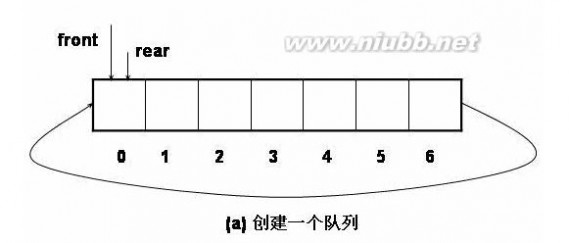
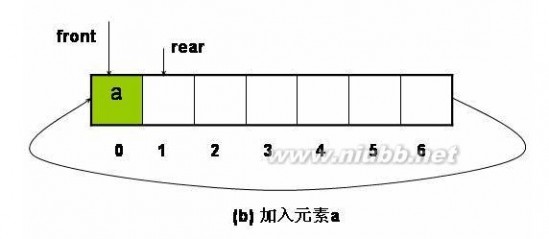
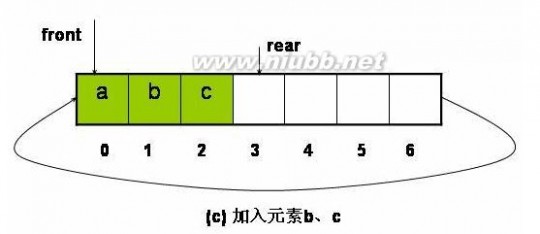
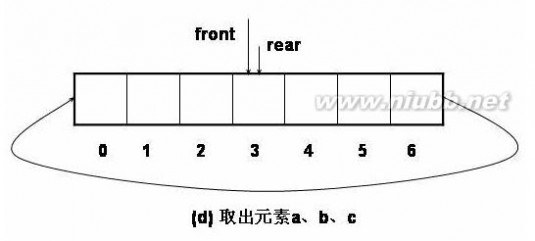
注意:
①当头尾指针相等时,队列为空。
②在非空队列里,队头指针始终指向队头元素,尾指针始终指向队尾元素的下一位置。3、顺序队列中的溢出现象 ① "下溢"现象
当队列为空时,做出队运算产生的溢出现象。“下溢”是正常现象,常用作程序控制转移的条件。
② "真上溢"现象
当队列满时,做进栈运算产生空间溢出的现象。“真上溢”是一种出错状态,应设法避免。
③ "假上溢"现象
由于入队和出队操作中,头尾指针只增加不减小,致使被删元素的空间永远无法重新利用。当队列中实际的元素个数远远小于向量空间的规模时,也可能由于尾指针已超越向量空间的上界而不能做入队操作。该现象称为"假上溢"现象。
四、循环队列为充分利用向量空间,克服"假上溢"现象的方法是:将向量空间想象为一个首尾相接的圆环,并称这种向量为循环向量。存储在其中的队列称为循环队列(CircularQueue)。
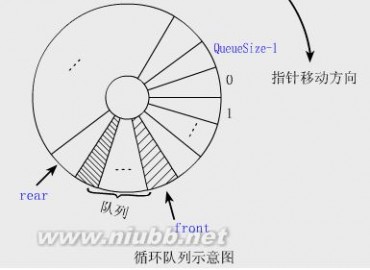 1、 循环队列的基本操作
1、 循环队列的基本操作循环队列中进行出队、入队操作时,头尾指针仍要加1,朝前移动。只不过当头尾指针指向向量上界(QueueSize-1)时,其加1操作的结果是指向向量的下界0。这种循环意义下的加1操作可以描述为:
① 方法一:
if(i+1==QueueSize) //i表示front或rear
i=0;
else
i++;
② 方法二--利用"模运算"
i=(i+1)%QueueSize;
2、 循环队列边界条件处理
循环队列中,由于入队时尾指针向前追赶头指针;出队时头指针向前追赶尾指针,造成队空和队满时头尾指针均相等。因此,无法通过条件front==rear来判别队列是"空"还是"满"。
解决这个问题的方法至少有三种:
① 另设一布尔变量以区别队列的空和满;
② 少用一个元素的空间。约定入队前,测试尾指针在循环意义下加1后是否等于头指针,若相等则认为队满(注意:rear所指的单元始终为空);
③使用一个计数器记录队列中元素的总数(即队列长度)。
3、程序#define DataType int#define MAXSIZE 100
using namespace std;
typedef struct_CirQueue{DataType data[MAXSIZE];int front; //头指针,队非空时指向队头元素int rear; //尾指针,队非空时指向队尾元素的下一位置}CirQueue, *pCirQueue;
void InitQueue(pCirQueue pQueue);bool Empty(pCirQueuepQueue);bool InsertQueue(pCirQueue pQueue, DataType x);DataType OutQueue(pCirQueue pQueue);DataType GetHead(pCirQueuepQueue);int GetLength(pCirQueue pQueue);
int _tmain(int argc, _TCHAR* argv[]){int len = 0, data;CirQueue myQueue;InitQueue(&myQueue);if (!Empty(&myQueue)){printf("Queue is Empty");}InsertQueue(&myQueue, 1);InsertQueue(&myQueue, 2);InsertQueue(&myQueue, 3);InsertQueue(&myQueue, 4);len = GetLength(&myQueue);data = GetHead(&myQueue);while (Empty(&myQueue)){data = OutQueue(&myQueue);cout<<endl<<data;}return 0;}
//初始化:初始化一个新的队列void InitQueue(pCirQueue pQueue){memset(pQueue, 0, sizeof(CirQueue));}
//队列非空判断:若队列不为空,则返回true;否则返回false。bool Empty(pCirQueuepQueue){if (pQueue->front !=pQueue->rear){return true;}else return false;}
//入队列:在队列的尾部插入元素x,使元素x成为新的队尾。若 队列满,则返回false;否则,返回true。bool InsertQueue(pCirQueue pQueue, DataType x){if ((pQueue->rear+1)%MAXSIZE !=pQueue->front) //判断队列是否已满{pQueue->data[pQueue->rear] =x;pQueue->rear = (pQueue->rear +1)%MAXSIZE;return true;}elsereturn false;}
//出队列:若队列不为空,则返回对头元素,并从对头删除该元素,对头指针指向原对头的后记元素;否则,返回元素NULLDataType OutQueue(pCirQueue pQueue){DataType data;if (pQueue->front ==pQueue->rear){return NULL;}else{data =pQueue->data[pQueue->front];pQueue->front = (pQueue->front +1)%MAXSIZE;return data;}}
//取对头元素:若队列不空,则返回对头元素;否则,返回空元素NULLDataType GetHead(pCirQueue pQueue){if (pQueue->front ==pQueue->rear){return NULL;}else{returnpQueue->data[pQueue->front];}}
//求队列长度int GetLength(pCirQueue pQueue){int length = 0, number = 0;for (number = pQueue->front; number%MAXSIZE< pQueue->rear; number =(number+1)%MAXSIZE){length++;}return length;}
运行结果:

三 : 循环队列的基本操作
实验目的及要求:
了解和掌握循环队列的特点;
掌握循环队列基本操作的实现;
要求完成循环队列的初始化、入队、出队、求队列长度、显示操作的实现。 实验设备环境及要求:
PC机一台,内存要求128M以上,VC++6.0集成开发环境。
实验内容与步骤:
1、在VC++6.0环境中新建一个工程和C++文件;
2、实现循环队列初始化、入队、出队、求队列长度算法,代码如下:
#include <stdio.h>
#include <malloc.h>
#define MAXQSIZE 5
typedef char QElemType;
typedef struct {
QElemType *base;
int front;
int rear;
}SqQueue;
int InitQueue(SqQueue &Q){
Q.base = (QElemType *)malloc(MAXQSIZE*sizeof(QElemType));
if(!Q.base) return 0;
Q.front = Q.rear =0;
return 1;
}
int QueueLength(SqQueue Q){
return (Q.rear-Q.front+MAXQSIZE) % MAXQSIZE;
}
int EnQueue(SqQueue &Q,QElemType e){
if((Q.rear+1) % MAXQSIZE == Q.front) {
printf("队列为满队列!!n");
return 0;}
Q.base[Q.rear] = e;
Q.rear = (Q.rear+1) % MAXQSIZE;
return 1;
}
int DeQueue(SqQueue &Q,QElemType &e){ if(Q.front == Q.rear) return 0;
e = Q.base[Q.front];
Q.front = (Q.front+1) %MAXQSIZE; return 1;
}
void DispQueue(SqQueue Q){
int m,i;
m = QueueLength(Q);
if(m ==0) printf("该队列为空队列!!n"); for(i = Q.front; i%MAXQSIZE!=Q.rear; i++) printf("%c",Q.base[i]);
printf("n");
}
void main(){
SqQueue Q;
QElemType e;
InitQueue(Q);
DispQueue(Q);
EnQueue(Q,'A');
EnQueue(Q,'B');
EnQueue(Q,'C');
EnQueue(Q,'D');
printf("队列长度为:");
printf("%dn",QueueLength(Q));
printf("队列为:");
DispQueue(Q);
DeQueue(Q,e);
printf("队列长度为:");
printf("%dn",QueueLength(Q));
printf("队列为:");
DispQueue(Q);
EnQueue(Q,'E');
printf("队列长度为:");
printf("%dn",QueueLength(Q));
printf("队列为:");
DispQueue(Q);
EnQueue(Q,'F');
printf("队列为:");
DispQueue(Q);
}
实验指导与数据处理:
实验结果:该队列为空队列!!
队列长度为:4
队列为:ABCD
队列长度为:3
队列为: BCD
队列长度为:4
队列为: BCDE
队列为满队列!!
队列为: BCDE
分析讨论:
本次实验通过对循环队列基本操作的实现,加深了对循环队列特点的理解,并且熟悉了VC++6.0集成环境,虽然在调试过程中遇到一些问题,但经分析后达到了预期的结果。
四 : 循环队列的基本操作
实验目的及要求:
了解和掌握循环队列的特点;
掌握循环队列基本操作的实现;
要求完成循环队列的初始化、入队、出队、求队列长度、显示操作的实现。(www.61k.com) 实验设备环境及要求:
PC机一台,内存要求128M以上,VC++6.0集成开发环境。
实验内容与步骤:
1、在VC++6.0环境中新建一个工程和C++文件;
2、实现循环队列初始化、入队、出队、求队列长度算法,代码如下:
#include <stdio.h>
#include <malloc.h>
#define MAXQSIZE 5
typedef char QElemType;
typedef struct {
QElemType *base;
int front;
int rear;
}SqQueue;
int InitQueue(SqQueue &Q){
Q.base = (QElemType *)malloc(MAXQSIZE*sizeof(QElemType));
if(!Q.base) return 0;
Q.front = Q.rear =0;
return 1;
}
int QueueLength(SqQueue Q){
return (Q.rear-Q.front+MAXQSIZE) % MAXQSIZE;
}
int EnQueue(SqQueue &Q,QElemType e){
if((Q.rear+1) % MAXQSIZE == Q.front) {
printf("队列为满队列!!n");
return 0;}
Q.base[Q.rear] = e;
Q.rear = (Q.rear+1) % MAXQSIZE;
循环队列 循环队列的基本操作
return 1;
}
int DeQueue(SqQueue &Q,QElemType &e){ if(Q.front == Q.rear) return 0;
e = Q.base[Q.front];
Q.front = (Q.front+1) %MAXQSIZE; return 1;
}
void DispQueue(SqQueue Q){
int m,i;
m = QueueLength(Q);
if(m ==0) printf("该队列为空队列!!n"); for(i = Q.front; i%MAXQSIZE!=Q.rear; i++) printf("%c",Q.base[i]);
printf("n");
}
void main(){
SqQueue Q;
QElemType e;
InitQueue(Q);
DispQueue(Q);
EnQueue(Q,'A');
EnQueue(Q,'B');
EnQueue(Q,'C');
EnQueue(Q,'D');
printf("队列长度为:");
printf("%dn",QueueLength(Q));
printf("队列为:");
DispQueue(Q);
DeQueue(Q,e);
printf("队列长度为:");
printf("%dn",QueueLength(Q));
printf("队列为:");
DispQueue(Q);
EnQueue(Q,'E');
printf("队列长度为:");
printf("%dn",QueueLength(Q));
printf("队列为:");
DispQueue(Q);
EnQueue(Q,'F');
printf("队列为:");
循环队列 循环队列的基本操作
DispQueue(Q);
}
实验指导与数据处理:
实验结果:该队列为空队列!!
队列长度为:4
队列为:ABCD
队列长度为:3
队列为: BCD
队列长度为:4
队列为: BCDE
队列为满队列!!
队列为: BCDE
分析讨论:
本次实验通过对循环队列基本操作的实现,加深了对循环队列特点的理解,并且熟悉了VC++6.0集成环境,虽然在调试过程中遇到一些问题,但经分析后达到了预期的结果。(www.61k.com]
五 : C++类模板实现循环队列

以下是本人用C++类模板实现的一种数据结构——循环队列。希望对人们有所帮助,也希望人们提出宝贵的意见!
//循环队列
#ifndef _QUEUE_H_INCLUDED
#define _QUEUE_H_INCLUDED
template<typename T>
class _queue
{
public:
_queue(size_t _capacity = 1):capacity(_capacity), length(0), pBase(new T[_capacity]),
pHead(pBase), pLast(pBase){}
~_queue(){delete []pBase;}
void ClearQueue()
{
pHead = pBase;
pLast = pBase;
length = 0;
}
bool IsEmpty()const {return !length;}
size_t GetLength()const {return length;}
T& GetHead()const {return *pHead;}
void Push(T &e);
T Pop();
void vist();
private:
void NewMenory();
void Insert(T &e);
size_t capacity;
size_t length;
T *pBase;
T *pHead;
T *pLast;
};
template<typename T>
void _queue<T>::NewMenory()
{
T *ptmpNew(new T[2*capacity]);
T *ptmpNewCopy(ptmpNew);
T *ptmpheadCopy(pHead);
T *ptmplimit(pBase + capacity -1);
for(int i = 0; i <capacity; ++i)
{
*ptmpNewCopy = *ptmpheadCopy;
if(ptmpheadCopy == ptmplimit)
{
ptmpheadCopy = pBase;
continue;
}
++ptmpNewCopy;
++ptmpheadCopy;
}
delete []pBase;
pBase = ptmpNew;
pHead = pBase;
pLast = pBase + capacity;
capacity *= 2;
}
template<typename T>
void _queue<T>::Insert(T &e)
{
if(pLast != (pBase + capacity))
{
*pLast = e;
++pLast;
}
else
{
*pBase = e;
pLast = pBase + 1;
}
}
template<typename T>
void _queue<T>::Push(T &e)
{
++length;
if(length > capacity)
NewMenory();
Insert(e);
}
template<typename T>
T _queue<T>::Pop()
{
if(length > 0)
{
--length;
if(pHead == pBase + capacity -1)
{
T tmp(*pHead);
pHead = pBase;
return tmp;
}
return *(pHead++);
}
return *pBase;
}
template<typename T>
void _queue<T>::vist()
{
T *ptmphead(pHead);
T * const ptmplimit(pBase + capacity);
for(int i = 0; i<length; ++i)
{
if(ptmphead == ptmplimit)
ptmphead = pBase;
std::cout<<" '"<<*ptmphead<<"' ";
++ptmphead;
}
}
#endif // _QUEUE_H_INCLUDED
